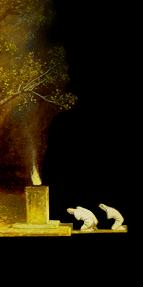 |
 |
 |
|
 |
|
| Mulholland Drive Review |  |
|
This is the girl.” Like “Now it’s dark” in Blue Velvet or “Fire walk with me” in the film version of Twin Peaks, “This is the girl” forms a sort of mantra in Mulholland Drive, writer-director David Lynch’s latest film. Uttered first by a dyspeptic mobster who’s very particular about his espresso, later by a menacingly polite cowboy who looks as if he just stepped out of an establishing shot from a Republic Pictures B western, and finally by an obdurate hotshot film director who’s eventually persuaded that only by saying those words can he get back the life that has been abruptly taken from him, it’s an initially neutral-sounding phrase that gains more currency every time it comes up. What it really “means”—what this whole, wholly astonishing film really “means”—will no doubt be a source of unending, fascinated speculation among Lynch cultists, as well as a provocation of genuine, foam-at-the-mouth frustration among those who got suckered into buying their tickets after hearing that the film contains a couple of really hot lesbian love scenes.
Not that it doesn’t, mind you—and it’s also worth noting that those scenes are rarities in the Lynch oeuvre, in that they don’t represent the act of physical love with complete revulsion. Indeed, the affair between amnesiac vamp Rita (Laura Elena Harring)—who, not remembering who she is, has cribbed her name from a poster of the movie Gilda—and perky Hollywood newbie Betty (Naomi Watts) is possibly the healthiest, most positive amorous relationship ever depicted in a Lynch movie—that is, for the duration of its healthy stage, which lasts about two minutes. The movie, which began as a pilot for a proposed television series and was reworked by Lynch into a stand-alone film after French producers stepped in with financing for new scenes, is a typically Lynchian sprawl (well over two hours), packed with bizarre characters, twisting plot lines, and unforgettable set pieces, with Rita and Betty’s story serving as its linchpin, so to speak. Although set in present-day L.A., the movie has the same unstuck-in-time feel that gave the great Blue Velvet much of its uncanny atmosphere.
More than anything else, Mulholland Drive is an incredible cinematic experience. You laugh, you wince, you fall in love, you hold your breath, you cringe, you mutter “Oh my God.” The movie is a nonstop catalog of classic Lynchian moments, from extreme discomfort (composer Angelo Badalamenti, a longtime Lynch collaborator, is ineffable as the espresso-rejecting mobster) to nostalgic reverie (a candy-colored doll with a beehive hairdo lip-synchs Connie Stevens’s “Sixteen Reasons” in a delightfully improbable movie-audition scene) to utter desolation (abandoned by a lover, a distraught woman seeks solace in masturbation; in a point-of-view shot, we see the brickwork above her fireplace snap in and out of focus) to sheer terror (embodied, finally, by two extremely creepy senior citizens). The only problem—and I need to lay my cards on the table and say that it wasn’t much of a problem for me, although for others it might be a big one—is exactly what the hell happens in this movie.
It’s pretty clear where Drive takes off from its TV pilot version; the lesbian scenes are a tip-off, plus the use of space within the frame opens up considerably. But Lynch did not use the big screen to tie up the loose ends of his various plot lines in a neat, or you might even say coherent, way. While the film’s emotional conclusion is quite definitive and remarkably devastating, the fact is that this is a mystery film where a lot of the riddles remain unanswered. It occurred to me, shortly after trying to shake off the emotional power of the film (it’s the kind of movie that makes the real world seem even weirder than usual when you step out of the theater), that Mulholland Drive is, in an oblique way, really a remake of Lynch’s first film, Eraserhead, and that left to his own devices, Lynch will, in some form or another, just make the same film over and over again. Roberto Rossellini once remarked of Chaplin’s A King in New York, “It is the film of a free man.” Mulholland Drive is the film of a slave—a slave to his own, undying obsessions. But that’s not necessarily a bad thing.
by Glenn Kenny - © 2001 Hachette Filipacchi Magazines Inc.
|
|
|
|
